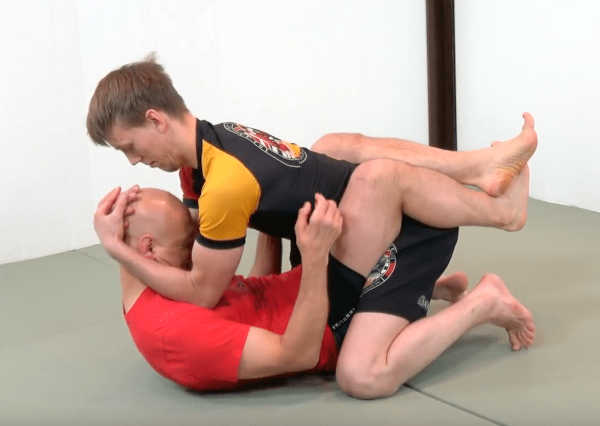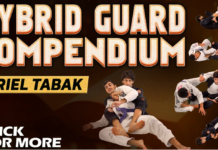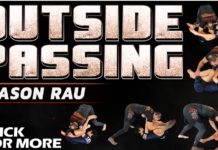How comfortable are you with “dirty” BJJ moves? Personally, I love them. Dirty is just a thing of perception if you ask me. Тhere are moves that are effective, and those that are less effective. And while all moves have the tendency to be dangerous, certain moves don’t really deserve the outlaw status they have in Jiu-Jitsu. it is subject ттхat has been beaten to death, but I really do think there’s a place for the BJJ can opener in every grappler’s toolbox.
The BJJ Can opener is one of those moves that are like something out of Harry Potter. Horrible analogy, I know, but bear with me. New folks come in, having seen something on YouTube, and ask the people in the gym about it. Suddenly they’re told to shut up and leave it alone. Иt is one of the “unspeakable” moves, that must never be mentioned, let alone done. Well, guess what? Demonizing moves actually makes them far more dangerous than teaching them.
What is Can Opener BJJ Submission?
So, what is the BJJ Can Opener? It is a spinal lock, in essence. The way it is used, though, is to make someone open a closed guard, as a result of pain. Not really the most technical way to open guard, but effective nonetheless. However, it is the spinal lock/neck crank thing that usually makes people resent it. To be honest, I have no idea if it will work, or to what extent at the highest levels. It is worth exploring, though.
How does Can Opener Works?
The way the can opener works is that you grab the back of the head of an opponent in what is basically a Thai clinch when you are the person caught in the closed guard. Simply pulling from there would get yo arm barred 9 times out of ten.
However, if your elbows are glued to the opponent’s chest, you’ll be able to cause quite the pressure on the spine, by pulling their chin to their chest. In most cases, people simply open the legs up and give up a pass. There are the few that think they can take it, and end up tapping to the can opener, although it is not a submission per see.
How to do Can Opener?
The way you can do it is either pulling directly from a base on your knees, or by stacking the opponent. Both have their merit, but the stack one can be particularly uncomfortable. Moreover, there’s the MMA/self-defense aspect of it, where this move is a really no-nonsense way to get rid of the closed guard. Moreover, the pressure on the spine is not that dangerous as it is pretty straightforward. In fact, passing with stuff like the Sao Paolo / Roger Gracie pass could be far worse for the bottom person’s spine.
How to defend Can Opener?
The first thing to have in mind is that if someone catches you with a Can Opener and you feel pain in your neck just tap. Tap early and tap often no matter if it’s legal or not in your gym.
The reason for tapping is pretty simple. Every time you don’t tap to any kind of neck crank it will come back to you later.
There are three main defenses are:
- Counter Can Opener with an armbar. Trap one arm, put your other hand under near partner’s leg, turn your hips and go for an armbar.
- Take your opponents head with your both arms and shove it below your head and push
- Open your guard. It’s not very good as you’ll be opened to other attacks.
A “Legal Disclaimer”
The first thing you need to know, you can’t do a BJJ can opener in an IBJJF match, Gi or No-Gi, regardless of your belt. Actually, you can, but it will get you disqualified. That said, in a different ruleset you might just end up on the receiving end of one, and that won’t really end great for you. The fact remains that the move is a bit bully-ish and should be done with care. However, that is all the more reason to train it.
Will the BJJ can opener work in a high-level black belt match in the Gi? Who knows? the reason that we don’t is down to the approach we have. The IBJJF rules have really prevented a lot of grappling movers to really get tested and improved through their constant use in competition. The fact that the move is illegal means we’ll never know if it is something worth exploring. There are a few instances of it working (to an extent) in MMA, and people that train No-Gi tend to use it from time to time.
What I think is that our whole approach to moves like the BJ can opener is wrong. Ok, they’re illegal and potentially dangerous. I get that and agree. Al the more reason to teach them properly. And yes, that does mean teach them to new students as well. Feel free to outlaw the move in rolling, but do give your students the chance to learn how to do it correctly and more importantly, how to act if they ever get caught in it.
Thinking Outside The Box
There are two basic premises for not using the BJJ can opener. One is that it will cause immediate and devastating damage to the spine. We saw that it doesn’t really do that. The other is that people will easily defend it if they open the guard. What most fail to grasp is that the can opener is not a submission but, as the name suggests, actually a way to open the closed guard. It just happens to have neck cranking properties as well.
The reason the Can Opener works is because of the Thai clinch position. That said, the move is based on breaking posture – a fundamental Brazilian Jiu-Jitsu principle. The longer you can hold a broken posture, and the more you can cause a bend in the spine, the less an opponent can do. So, how can you take this knowledge and combine it with BJJ can opener to achieve other goals apart from opening the closed guard?
Here’s a radical idea courtesy of Priit Mihkelson – escape the mount. When you come to think about it, the mount is just a guard in reverse. Granted, the top person’s legs are not connected, meaning the Can opener / Thai clinch will serve merely as a posture break. Here’s another hint – it is not illegal. So, next time you’re in the bottom mount, and you can catch a Thai clinch without giving an armbar (you’d be surprised at how easy it is to get the clinch), do it. Then pull like your life depends on it, and only then go for your bridge and roll. Suddenly, escaping the mount becomes a lot easier. Not to mention you can pass the guard directly as you have a can opener in place that won’t allow your opponents to even close the guard.
Conclusion
Demonizing moves is never a good idea. Of course, not every move from other grappling martial arts is a good fit for BJJ. But then again, neither were Judo/Sambo leg locks, until John Danaher modified them. That just means we can, and should try and modify and play with as many different techniques as possible before even thinking about disregarding them. the BJJ can opener is a great one to have fun with, legal or not.


![Darce Choke Encyclopedia – Origins, Mechanics and Variations [2025] BJJ, choke, Brabo, BJJ Darce Choke, D'arce Choke, Darce BJJ Choke](https://bjj-world.com/wp-content/uploads/2017/11/JungPoirierLeeYahoo-218x150.jpg)












![Jeff Higgs Self Defense Guard BJJ DVD Review [2024] Jeff Higgs Self Defense Guard BJJ DVD Review](https://bjj-world.com/wp-content/uploads/2024/09/jeff-higgs-self-defense-guard-bjj-dvd-review-324x235.png)


![Reverse Arm Bar System Andrew Kerfoot DVD Review [2024] Reverse Arm Bar System Andrew Kerfoot DVD Review](https://bjj-world.com/wp-content/uploads/2024/10/reverse-arm-bar-system-andrew-kerfoot-dvd-review-100x70.png)
![360 Degrees Guard Retention Thiago Abud DVD Review [2024] 360 Degrees Guard Retention Thiago Abud DVD Review](https://bjj-world.com/wp-content/uploads/2024/10/360-degrees-guard-retention-thiago-abud-dvd-review-100x70.png)


![Dynamic De La Riva Guard Otavio Sousa DVD Review [2025] Dynamic De La Riva Guard Otavio Sousa DVD Review](https://bjj-world.com/wp-content/uploads/2025/02/dynamic-de-la-riva-guard-otavio-sousa-dvd-review-100x70.png)

![Full Guard Formula James Booth DVD Review [2025] Full Guard Formula James Booth DVD Review](https://bjj-world.com/wp-content/uploads/2025/02/full-guard-formula-james-booth-dvd-review-100x70.png)


![Miko Hytonen Lapel Chokes From Everywhere DVD Review [2024] Miko Hytonen Lapel Chokes From Everywhere DVD Review](https://bjj-world.com/wp-content/uploads/2024/10/miko-hytonen-lapel-chokes-from-everywhere-dvd-review-100x70.png)
![Slip N Slide Into Victory Julián Espinosa DVD Review [2025] Slip N Slide Into Victory Julián Espinosa DVD Review](https://bjj-world.com/wp-content/uploads/2025/01/slip-n-slide-into-victory-julian-espinosa-dvd-review-100x70.png)

![Flow Pressure Kauan Barboza DVD Review [2025] Flow Pressure Kauan Barboza DVD Review](https://bjj-world.com/wp-content/uploads/2025/02/flow-pressure-kauan-barboza-dvd-review-100x70.png)




![10th Planet Leg Locks Jeremiah Vance DVD Review [2025] 10th Planet Leg Locks Jeremiah Vance DVD Review](https://bjj-world.com/wp-content/uploads/2025/01/10th-planet-leg-locks-jeremiah-vance-dvd-review-100x70.png)

![Wristlocks From The Top Pete Letsos DVD Review [2025] Wristlocks From The Top Pete Letsos DVD Review](https://bjj-world.com/wp-content/uploads/2025/01/wristlocks-from-the-top-pete-letsos-dvd-review-100x70.png)
![Shin to Shin Eoghan O’Flanagan DVD Review [2025] Shin to Shin Eoghan O'Flanagan DVD Review](https://bjj-world.com/wp-content/uploads/2024/12/shin-to-shin-eoghan-oflanagan-dvd-review-100x70.png)
![Kill The Underhook Dima Murovanni DVD Review [2024] Kill The Underhook Dima Murovanni DVD Review](https://bjj-world.com/wp-content/uploads/2024/10/kill-the-underhook-dima-murovanni-dvd-review-100x70.png)

![Jeff Glover Deep Half Revolution DVD Bundle Review [2024] Jeff Glover Deep Half Revolution DVD Bundle Review](https://bjj-world.com/wp-content/uploads/2024/10/jeff-glover-deep-half-revolution-dvd-bundle-review-100x70.png)
![Intro To Hip Mobility for Guard Players Joshua Presley DVD Review [2024] Intro To Hip Mobility for Guard Players Joshua Presley DVD Review](https://bjj-world.com/wp-content/uploads/2024/09/hip-mobility-for-guard-joshua-presley-dvd-review-100x70.png)